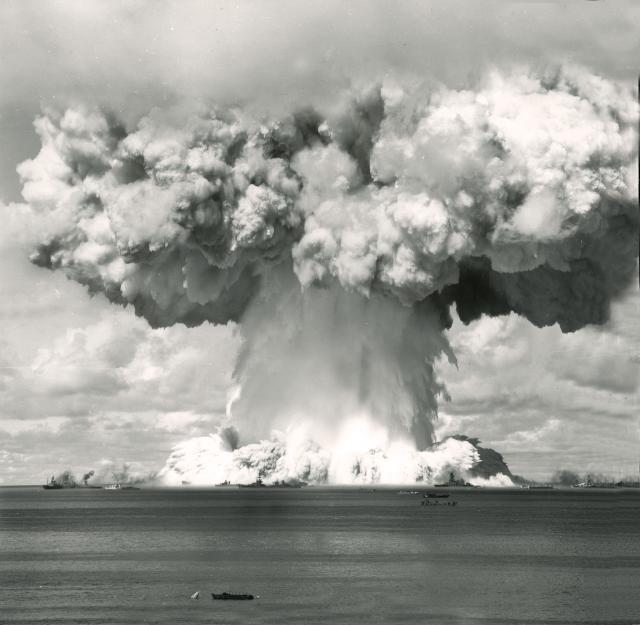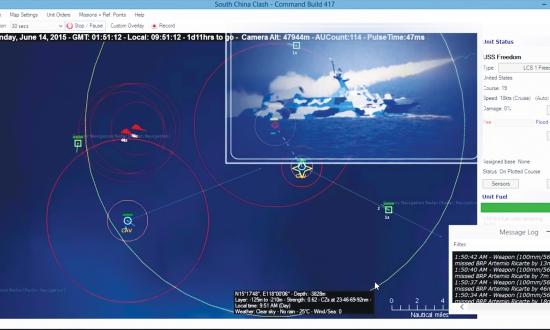The recent deployment of the W-76-2 nuclear warhead on board Ohio-class ballistic-missile submarines marks the introduction of the Navy’s first new nuclear weapon in decades—and perhaps not the last. Although tactical nuclear weapons were withdrawn from warships in 1991, tensions with Russia and China today could lead to a new generation of sea-based nonstrategic nuclear weapons. (See “Tactical Nuclear Weapons Are Back,” pp. 48–53, April 2018.) It is worth a look at the development of naval nuclear weapons in the Cold War and where they might be heading against today’s threats.
The Navy, having seen the destructive power of nuclear weapons unleashed on the cities of Hiroshima and Nagasaki, moved quickly after the war to determine the threat to ships at sea. Operation Crossroads, a pair of joint Army-Navy tests against a fleet of retired and captured warships simulating a battle fleet, determined that a sea-based nuclear explosion could do immense damage to a fleet. The second test, “Baker,” involved the underwater detonation of a fission device identical to that dropped on Nagasaki. The explosion sank eight ships, including the aircraft carrier USS Saratoga (CV-3) and two battleships, and severely damaged eight more. What is more, the surviving ships were blanketed with radioactive fallout that would have killed their crews within hours or days.
While Crossroads did demonstrate the great harm nuclear weapons could do to a fleet, the Navy also realized it would be difficult for the Soviet Union to launch such an attack under wartime conditions. As long as a fleet kept moving and maintained local air superiority, it could avoid nuclear attack.
The Navy fielded a number of tactical nuclear weapons, especially after the Eisenhower administration’s New Look policy of 1955. New Look placed an increased reliance on tactical nuclear weapons as a means of maintaining the firepower to fight and win a war without large standing armed forces. The Navy fielded both offensive and defensive nuclear weapons.
Tactical nuclear weapons were adapted for antisubmarine warfare relatively quickly. The destructive power of a nuclear weapon made direct hits on enemy submarines unnecessary. The Wigwam underwater nuclear test of 1955 demonstrated that a 30-kiloton device could sink a submarine one mile away; smaller weapons could still rupture a pressurized hull from a distance of hundreds of yards. Nuclear weapons promised to cut down much of the slow, methodical process of antisubmarine warfare, allowing more efficient prosecution of enemy submarines.
One example of antisubmarine nuclear weapons was similar to the (non-nuclear) Mk 46 vertical-launch antisubmarine rocket (VL-ASRoc). The RUR-5 AsRoc was fired from an eight-round box launcher (which could also house Mk 46 lightweight torpedoes). It had a maximum range of six miles and carried a 10-kiloton W44 nuclear warhead. The UUM-44 Submarine Rocket (SubRoc) was a similar rocket-powered weapon fired from submarine torpedo tubes. SubRoc had a range of 35 miles and carried a one kiloton W55 nuclear warhead.
Carrier-based aircraft also carried low-yield nuclear weapons. Almost all attack jets—A-1 Skyraiders, A-6 Intruders, A-7 Corsair IIs, F/A-18 Hornets, and others—had a nuclear mission, with pilots trained to “toss-bomb” nuclear weapons at their targets. Navy aircraft carried the B43, B57, and B61 nuclear gravity bombs. The bombs were available in different versions with different yields—except for the B61, which has a “dial-a-yield” system. The B61 Mod 9, for example, could be set to detonate with a yield ranging from 10 to 500 kilotons. This range of weapons and yields allowed Navy jets to attack tactical battlefield targets or strategic targets in the enemy homeland, depending on the mission.
Defensive nuclear antiaircraft missiles enjoyed a relatively short career in U.S. Navy service. The Navy’s Talos and Terrier missiles, both large air-defense missiles launched by twin arm launchers, could carry conventional or tactical nuclear warheads (in the 1- to 5-kiloton range). Nuclear warheads were judged useful in defending carriers against Soviet bombers, because even a near miss would down a Tupolev Bear bomber. Advances in missile range and accuracy—and a desire to shift away from battlefield nuclear weapons—saw nuclear-tipped air-defense weapons retired after about two decades.
In the early 1980s, the Navy deployed both antiship and land-attack versions of the Tomahawk sea-launched cruise missile. The nuclear land-attack version, BGM-109A TLAM-N, had a range of 1,550 miles and carried a 150-kiloton W80-0 warhead. Introduced into the fleet in 1983, 350 warheads were spread across 183 Navy ships, including Iowa-class battleships, cruisers, destroyers, and attack submarines.
In September 1991, then-President George H. W. Bush announced the withdrawal of all tactical nuclear weapons from submarines, surface ships, and land-based aircraft. These weapons were kept in reserve and eventually destroyed, and today the only nuclear weapons remaining in the fleet are those arming Trident II D-5 submarine-launched ballistic missiles. (TLAM-N was removed from the fleet in 1991, and the W80-0 warheads were retired in 2011.)
The rise of China’s People’s Liberation Army Navy and the slow resuscitation of Russia’s navy has reintroduced the prospect of big power warfare and a new Cold War with one or both powers. If policymakers were to decide to redeploy tactical nuclear weapons to sea, what new weapons could get the nod?
The easiest weapon to reintroduce would be nuclear gravity bombs. The Air Force is preparing to certify the F-35A to carry the new B61-12 bomb. Like its B61-series predecessors, the B61-12 incorporates “dial-a-yield,” allowing the weapon to detonate with a force equivalent to 300 tons, 1.5 kilotons, 10 kilotons, or 50 kilotons of TNT. The Air Force’s work on F-35A certification should make certifying the F-35C to carry the B61-12 a relatively straightforward process. Newer aircraft carriers may need to revive the nuclear weapon W Division and set aside special secure handling and storage spaces for nuclear bombs, and pilots would need to be trained in delivery procedures.
Another step might be to reintroduce antisubmarine nuclear weapons, to ensure the rapid destruction of Russian, Chinese, or even North Korean submarines carrying their own nuclear weapons. Nuclear-capable versions of the VL-ASRoc and SubRoc could become a priority. The Navy might even resuscitate the 1980s-era UUM-125 Sea Lance program or something similar, developing a single weapon capable of operating from both the Mk 41 vertical launch system and 21-inch-diameter torpedo tubes. Although Sea Lance was stymied by difficulties with the dual modes, the Toma-hawk land-attack cruise missile does both quite well today.
One particularly dangerous underwater system that could merit a nuclear counter is Russia’s Poseidon intercontinental torpedo. (See “Kanyon’s Reach: Rethinking the Nuclear Triad in the Autonomous Age,” pp. 18–23, July 2020.) A nuclear-powered, nuclear-armed auto-nomous torpedo, Poseidon is reportedly capable of delivering a 2-megaton thermonuclear warhead against an enemy shore-based target or carrier battle group. Poseidon has a reported speed of 70 knots and a maximum depth of 3,280 feet. The combination of these characteristics make the Kremlin’s new apocalypse torpedo difficult to destroy with the current generation of undersea weapons.
Poseidon is a unique weapon with the capability to destroy a large population center and thus requires special attention. Weapons such as the sub-launched Mk 48 Advanced Capability torpedo might be adapted to use nuclear warheads to destroy the deeper-diving Poseidon, though neither ships nor aircraft can currently launch the Mk 48. A new, high-speed, deep-diving weapon capable of being launched from subsurface, surface, and air is probably necessary, one with either a conventional or nuclear warhead.
At present, there is no clear requirement to reintroduce tactical nuclear weapons at sea. However, intelligence reports suggest Russian ships and subs have resumed carrying such weapons on routine patrols. Other factors, including the deployment of such weapons by the People’s Liberation Army Navy, could require the United States to respond in kind. Ideally, adversaries will be deterred from such deployments by the knowledge that the U.S. Navy safeguarded an arsenal of tactical nuclear weapons for decades and could easily do so again.







